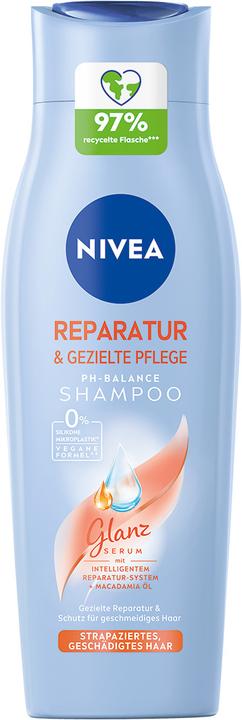

Stiftung Warentest tests repair shampoos
Heat and water from the pool or sea are a challenge for our hair: many of us have to deal with a damaged mane, especially in summer. Stiftung Warentest has now analysed which care shampoos are any good.
You know who doesn't like summer, sun and sea? Your hair. Many people struggle with a split, brittle mane, especially in the hot season. A repair shampoo is supposed to help. The Stiftung Warentest has investigated which products fulfil this promise (access to the article is subject to a charge). And put 13 liquid and four solid shampoos to the test
The result
The majority of the results were positive: although none of the test items were rated "very good", nine of the 17 shampoos analysed were rated "good". The overall winners were therefore five liquid shampoos, all of which scored a "2.1".
These include Lavera Expert Repair & Deep Care, Nivea Repair & Targeted Care, Olaplex No. 4 Bond Maintenance, Pantene Pro-V Repair & Care and Gliss Kur Total Repair. The products from Lavera, Pantene Pro-V and Gliss Kur received the best marks in the sub-category "care properties" - i.e. in the area that analyses the actual effect on the hair.
The five test winners were closely followed by the first solid shampoo in the ranking: Foamie Hibiscus achieved a "2.2".
The liquid shampoos "Repairing Shampoo" from Garnier and "Deep Restoration" from Guhl came in at the bottom of the rankings, both scoring 3.1, with "Intensive Care" from the Rossmann brand Isana and the solid shampoo from Nature Box bringing up the rear with a score of 3.3.
The shampoo with the highest score was the "Intensive Care" from the Rossmann brand Isana.
Drugstore own brands are not convincing
The testers praised the two shampoos from Gliss Kur and Nivea as price tips, with the latter also being one of the most environmentally friendly - along with the natural product Lavera and all four solid shampoos. This is because they do not contain any poorly biodegradable ingredients.
It was also noticeable that the cheaper shampoos tested, such as the own brands from Rossmann, Dm and Lidl, were not convincing: The overall care performance was said to be insufficient.
The test procedure
The evaluation criteria included the categories of care properties, application, packaging and declaration. The shampoos were tested by trained hairdressers on 20 participants. The hair of the individual test subjects was divided up and two different, anonymised shampoos - one on the left and one on the right - were applied. After the shampoo was applied and rinsed out, the focus was on the combability of wet hair and later on the shine and smoothness of dry hair.
Experts also scrutinised the ease of use of the shampoo, the handling of the packaging in terms of opening, closing and removing, as well as the truthfulness of the advertising claims and content information. The recyclability of the packaging was also assessed.
Why repair shampoos at all?
The task and mode of action of such products is to attach care substances to damaged areas. They are applied over and around the individual hairs.
By the way, the term repair shampoo is rather misleading, as nothing is repaired here: "A shampoo cannot restore damaged hair to a state of new growth," Professor Thomas Gassenmeier told Stiftung Warentest. He works at the Ostwestfalen-Lippe University of Applied Sciences and is an expert in cosmetics and detergents. Repair shampoos are nevertheless worthwhile, he adds. Even if they don't help damaged hair to become flawless, most of them still improve its condition.



